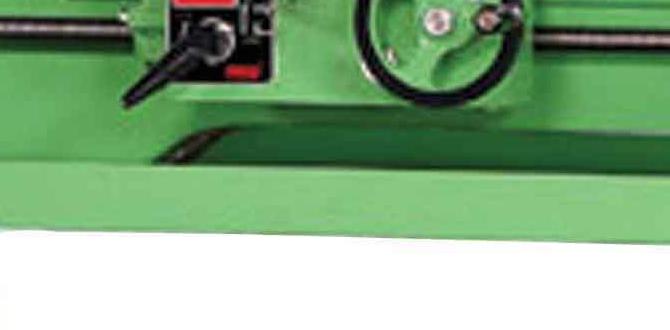Quick Summary: Master carbide end mills for cleaner cuts and longer tool life! This guide offers 52 essential tips covering selection, setup, feeds, speeds, and maintenance, making milling easy for beginners.
Hey everyone, Daniel Bates here from Lathe Hub! Ever found yourself staring at a carbide end mill, wondering if you’re using it just right? You’re not alone! These powerful tools can seem a bit daunting at first, with all the different types, sizes, and ways to use them. When you’re starting out with a metal lathe or milling machine, getting to grips with your cutting tools is super important. Messing up an end mill, or worse, your workpiece (or even yourself!), is something we all want to avoid. But don’t worry! I’m here to break down everything you need to know about carbide end mills. We’ll cover how to pick the right one, set it up correctly, and use it like a pro. Get ready to make your milling projects smoother and more successful than ever. Let’s dive in!
What’s So Special About Carbide End Mills?
Carbide end mills are like the workhorses of the machining world. They’re made from a super tough material called tungsten carbide, which is incredibly hard and can handle high temperatures. This means they can cut through a wide range of materials, from soft plastics to super hard metals, much faster and more efficiently than older tools like ones made from High-Speed Steel (HSS). Because they’re so durable and can cut at higher speeds, they’re a favorite for both beginners and seasoned machinists.
Choosing the Right Carbide End Mill
Picking the perfect end mill can make all the difference. Here are some key things to consider:
1. Material You’re Cutting
Different materials need different end mills. For softer materials like wood or plastic, a sharper, more aggressive cutter might work. For metals, you’ll need something designed for that specific metal’s hardness and heat.
2. Number of Flutes (Teeth)
The flutes are the spiral grooves on the end mill. More flutes generally mean a smoother finish and can handle harder materials, but they also eject less material (swarf). Fewer flutes are better for softer materials because they clear chips more easily.
- 2 Flutes: Great for plunging (drilling down) and slotting in softer materials.
- 3 Flutes: A good all-rounder, can handle a variety of materials.
- 4+ Flutes: Ideal for finishing passes and harder materials.
3. End Mill Type
There are many types, but for beginners, focus on these:
- Square End Mills: The classic shape, used for general milling, creating slots, and profiles.
- Ball End Mills: Have a rounded tip, perfect for creating curved surfaces, 3D contours, and fillets.
- Corner Radius End Mills: Similar to square end mills but with a small radius on the corners. This adds strength to the workpiece corner and helps prevent chipping.
4. Shank Size
The shank is the part that goes into your tool holder. Common metric sizes include 6mm, 8mm, 10mm, and 12mm. Make sure your tool holders can accept the shank diameter you choose. For example, if you’re looking for a “carbide end mill 3/16 inch 10mm shank,” ensure your collet or chuck fits a 10mm shank. The 3/16 inch likely refers to the cutting diameter.
5. Length of Cut and Overall Length
Consider how deep you need to mill and how far the cutting flutes extend up the tool. A “long reach” end mill has a longer flute length, allowing you to mill deeper slots or pockets.
Essential Setup Tips for Success
Getting your end mill set up right is just as crucial as picking the right one. A small mistake here can lead to a broken tool or a poor finish.
6. Cleanliness is King
Always ensure your collet, tool holder, and the end mill shank are perfectly clean. Any dirt, chips, or grease can cause runout (wobble) and vibration, leading to tool breakage or a bad cut.
7. Proper Collet/Tool Holder Selection
Use a collet or tool holder that matches the shank diameter of your end mill exactly. For example, if you have a 10mm shank end mill, use a 10mm collet. A collet that’s too large will not grip the end mill properly, and one that’s too small won’t let the end mill seat fully.
8. Secure the End Mill Fully
Insert the end mill deep enough into the tool holder, usually past the last cutting flute. Most tool holders have a minimum insertion depth marking. This ensures maximum support and prevents bending or vibration.
9. Check for Runout
High-quality tool holders and collets minimize runout. If you don’t have a good tool holder, consider investing in one. Excessive runout is a primary cause of chatter, poor surface finish, and premature tool wear. You can check runout with a dial indicator against the shank and flutes when the spindle is stationary but locked.
10. Coolant or Lubrication
For most metal machining, a coolant or cutting fluid is essential. It:
- Cools the cutting edge, preventing it from overheating and dulling.
- Lubricates the cut, reducing friction and chip welding.
- Helps clear chips away from the cutting zone.
For some plastics or softer materials, air blast might be sufficient, or no coolant might be needed.
Feeds and Speeds: The Magic Numbers
This is where many beginners struggle. Feeds and speeds determine how fast the end mill rotates (spindle speed) and how fast it moves through the material (feed rate). Getting these wrong is a common cause of chatter, tool breakage, and poor results. The ideal settings depend heavily on the end mill, the material, and the machine’s rigidity.
11. Understand Spindle Speed (RPM)
Spindle speed is measured in revolutions per minute (RPM). It’s how fast the spindle (holding the end mill) turns. Higher speeds often mean faster cutting but can also generate more heat.
12. Understand Feed Rate
Feed rate is how fast the tool moves along the workpiece, usually measured in inches per minute (IPM) or millimeters per minute (mm/min). It’s directly related to the chips being produced.
13. Chip Load is Key
Chip load is the thickness of the chip being removed by each tooth of the end mill. This is the most critical factor for tool life and cutting efficiency. Too small a chip load and you get rubbing and heat; too large and you risk breaking the tool or machine. For a 3-flute end mill, the formula is roughly: Feed Rate / (RPM Number of Flutes).
14. Start Conservatively
When in doubt, always start with lower RPM and feed rates than recommended. You can always increase them gradually if things are going well.
15. Use Online Calculators (with caution!)
Many manufacturers and machining websites offer feed and speed calculators. These are great starting points, but remember they are general guidelines. Always listen to your machine and the cutting sound.
For example, a common starting point for a 1/4 inch (6.35mm) carbide end mill in aluminum might be around 15,000-20,000 RPM and a feed rate of 15-30 IPM, but this varies wildly. When factoring in a specific situation, like a “carbide end mill 3/16 inch 10mm shank long reach for plywood reduce chatter,” we need to adjust. Plywood is softer and gummier than metal, so you’ll want slower speeds and higher feed rates to prevent burning and chatter. For reducing chatter, a helix angle on the end mill (often 30-45 degrees) and climb milling can help significantly.
16. Material Hardness Matters
Softer materials like aluminum or plastics can often be cut at higher speeds than harder steels. Always refer to charts or recommendations for the specific material you are machining.
17. Look at the End Mill Coating
Some end mills have coatings (like TiN, TiAlN, or ZrN) that improve hardness, reduce friction, and increase heat resistance. Coated end mills can often run at higher speeds and feeds.
Cutting Strategies and Techniques
How you approach the cut can significantly impact the performance of your end mill.
18. Conventional Milling vs. Climb Milling
- Conventional Milling: The cutting tool rotates against the direction of feed. This tends to lift the workpiece but can be more forgiving on older, less rigid machines.
- Climb Milling: The cutting tool rotates in the same direction as the feed. This produces a cleaner cut, puts less stress on both the tool and the machine, and is generally preferred for modern CNC machines. It’s particularly good for reducing chatter.
19. Stepover and Depth of Cut
Stepover: The amount the end mill is offset sideways from one pass to the next. A smaller stepover gives a smoother surface finish but takes longer.
Depth of Cut (DOC): How deep the end mill cuts into the material on each pass. Taking smaller depths of cut puts less strain on the tool and machine and is safer for beginners.
20. Reduce Chatter
Chatter is that annoying, high-pitched buzzing or vibration. To reduce it:
- Ensure your machine is rigid and well-maintained.
- Use the shortest possible end mill for the job.
- Minimize overhang (how much of the end mill sticks out).
- Use a smaller DOC and stepover.
- Experiment with your feeds and speeds – sometimes a small adjustment makes a big difference.
- Consider using fewer flutes for better chip evacuation or end mills with variable pitch/helix to break up harmonic vibrations.
- For a “carbide end mill 3/16 inch 10mm shank long reach for plywood reduce chatter,” you’ll want to try climb milling and ensure you’re not taking too deep a cut. Plywood can be prone to chipping or burning, so sharp flutes and a good chip clear are vital.
21. Single Pass vs. Multiple Passes
For roughing cuts, you might take a larger depth of cut. For finishing, a very light pass with a small stepover is best for a smooth surface. Never try to take a full-depth cut in one go if the recommended DOC is much smaller – you risk breaking the tool.
22. Plunge Cuts
When plunging straight down into material, a 2-flute end mill is often best as it acts more like a drill and clears chips better. Always plunge at a controlled feed rate, not at your maximum cutting feed rate.
23. Pocketing and Slotting
When milling pockets or slots, ensure your feed rate is appropriate for the material and the end mill’s chip load. For deep slots, you might need to take multiple passes to clear chips effectively and avoid overheating.
Maintaining Your Carbide End Mills
Even the best end mills will perform poorly if not cared for. Proper maintenance extends their life and ensures consistent results.
24. Cleaning After Use
Always clean your end mills thoroughly after each use. Remove all chips, coolant residue, and oil. A brush and some solvent cleaner work well. Dry them completely to prevent rust.
25. Inspect for Dulling or Chipping
Before and after use, examine the cutting edges for any signs of wear, dulling, or chips. A dull or chipped end mill is inefficient and can damage your workpiece or lead to breakage.
26. Preventing Corrosion
Although carbide is more corrosion-resistant than steel, it’s still good practice to store your end mills in a dry place. A light coating of a rust-inhibiting spray or oil can offer extra protection for longer-term storage.
27. Proper Storage
Store your end mills in a way that protects their cutting edges. Tool racks, cases, or holders designed for end mills are ideal. Avoid them rolling around loose in a toolbox where they can get damaged.
Advanced Tips for Better Results
Once you’re comfortable with the basics, these tips can help you refine your skills.
28. Use Multi-Flute End Mills for Finishing
For achieving a very smooth surface finish, end mills with 4 or more flutes are generally preferred. They take smaller chips per revolution, leading to a finer surface. For a “carbide end mill 3/16 inch 10mm shank long reach for plywood reduce chatter,” consider a specialized router bit for wood with a similar profile if you’re not getting the desired finish with a standard end mill, as router bits are designed for wood and often have more aggressive chip breaking features.
29. Variable Pitch End Mills
These have flutes that are not evenly spaced. This unevenness helps to break up the harmonic vibrations that cause chatter, making them very useful in less rigid setups or for noisy cutting operations.
30. Helical Interpolation
This is a 3D milling technique where the end mill moves in a circular path while also moving downwards. It’s excellent for creating large-diameter holes or very smooth internal contours. This requires precise CNC control but is a powerful capability.
31. Center Cutting vs. Non-Center Cutting
A center-cutting end mill has cutting edges that extend to the very tip, allowing it to plunge straight down. A non-center-cutting end mill has a small un-sharpened area in the center and cannot be plunged vertically; it must be fed in at an angle or use a helical interpolation method.
32. Ball End Mills for True 3D Surfaces
When you need to create complex, curved surfaces, like those found in molds or artistic carvings, a ball end mill is your go-to. They allow for smooth, flowing cuts.
33. Consider the Radius on Corner Radius End Mills
The radius on the corner helps prevent stress concentration and chipping at the corner of a milled feature. The size of the radius should generally be at least twice the chip load to be effective.
Specific Considerations for Plywood and Similar Materials
When milling materials like plywood, MDF, or particleboard, there are a few extra things to keep in mind, especially if you’re dealing with chatter and a “carbide end mill 3/16 inch 10mm shank long reach for plywood reduce chatter.”
34. Chip Evacuation is Crucial
Wood dust and chips can quickly fill the flutes of an end mill. Using an end mill designed for wood or plastics often means fewer flutes and a more open flute geometry for better chip clearance. A vacuum system connected to your dust extraction can also help immensely.
35. Heat and Burning
Wood can burn if the end mill is too slow or the feed rate is too low, leading to excessive friction. This is why using appropriate speeds and higher feed rates (to get adequate chip load) is important. For softer materials, you might experiment with higher RPMs than you would for metal.
36. Router Bits vs. End Mills
While you can* use end mills on wood, specialized router bits often perform better. They are designed with different cutting geometries and chip-breaking features ideal for wood. If you’re doing a lot of woodworking, consider investing in bits made for that purpose. A 3-flute “O-flute” router bit (which has only one effective cutting flute, designed for plastics and wood) or a compression bit might be good for plywood.
37. Climb Milling for a Smooth Edge
As mentioned earlier, climb milling is excellent for achieving a cleaner edge finish and can help reduce tear-out and chatter in wood products.
38. Single Flute “O-Flute” Bits for Plastics/Wood
These are highly specialized and work very well for clean cuts in both plastics and wood. They have a large flute space for excellent chip ejection. They often run at high RPMs with a controlled feed rate.
39. Consider Spoilboard Flattening Bits
If you’re using a CNC router for large wood projects, a spoilboard surfacing bit is used to flatten the surface you’ll be working on, ensuring your workpiece is perfectly level. This is more for the surface of your work area, not the end mill itself, but it’s related to getting good results in wood.
Troubleshooting Common End Mill Problems
Even with the best practices, issues can arise. Here’s how to tackle them.
40. Tool Breakage
Causes: Incorrect feeds/speeds, dull tool, insufficient clamping, too deep a cut, plunging incorrectly, poor chip evacuation.
Solutions: Double-check your settings, use a sharp tool, ensure secure workholding





